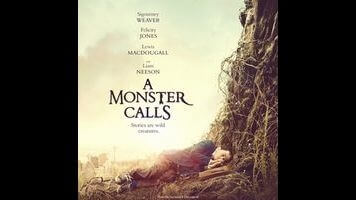The family melodrama A Monster Calls alternately conforms to expectations and defies them, which is probably why it’s already proved divisive during its run on the fall festival circuit. Some have called the film unsophisticated, saying that it makes well-meaning but obvious observations about how grief affects the young. Others connect with it on such a deep level that they can’t understand why anyone wouldn’t be moved. In a way, the confusion over what this movie is meant to be—and who’ll want to watch it—befits a story that’s so tough to take at times, about an imaginative child coping with the unimaginable.
In a literal sense, the “monster” in A Monster Calls is an enormous fire-breathing tree-beast, with the voice of Liam Neeson, who comes at night to haunt a preteen boy named Conor O’Malley (played by Lewis MacDougall). Five minutes into the film, though, as Conor’s shuffling pills around and listening to coughing fits from his mother, Lizzie (Felicity Jones), the title’s meaning quickly changes, as The Monster clearly comes to represent something else. And it’s nothing quite as obvious as “the real monster is cancer” either. There’s a bit more to what A Monster Calls is saying about how the process of dying transforms the living.
Director J.A. Bayona previously helmed the excellent The Orphanage and the controversial The Impossible. He and screenwriter Patrick Ness adapt Ness’ own award-winning children’s book, which itself evolved from a project left unfinished by the late Siobhan Dowd. The plot follows a fairly traditional fantasy fiction model. Conor is a lonely, artistically inclined boy, who’s bullied at school and alienated from both his absentee father (Toby Kebbell) and strict grandmother (Sigourney Weaver). Each night at 12:07 a.m., The Monster arrives and tells Conor a story that he implies will help Conor understand what’s happening to his family. He also warns that once all the stories have been told, it’ll be Conor’s turn to tell one of his own—and that it has to be true, or else he’ll suffer through his worst nightmare.
The Monster’s twisted little morality tales are the best parts of A Monster Calls. Rendered in animation designed to look like watercolors—and narrated in Neeson’s commanding growl—the stories speak of witches and princes and ancient grudges, and each takes an unexpected turn that leaves Conor more confused than ever. None of them follow the usual arc of good triumphing over evil. They’re all jumbled up and inconclusive, describing a world that’s much messier than even the brightest kid could comprehend.
The same could be said of the way Bayona and Ness handle the non-fantasy scenes. The muted colors and documentary-like handheld shots make A Monster Calls feel exhausted and edgy right from the start, in ways that some will find unpleasant. But the film also adds elements of mystery and wonder, like the locked room in Conor’s grandma’s house, or the way the adults all seem to know more about what’s going on than he does. And every time the narrative seems to be headed toward some pat, sentimental revelation about loss and healing, it lands just a little off-center, avoiding predictability.
A Monster Calls is still a film pitched primarily at the young, which means it’s more simplistic than a lot of adult audiences will prefer. Even though it packs surprises in its particulars, the broader strokes of the plot are easy to see in the opening minutes. And in the end, this is a movie about a boy watching his mom die of cancer, which isn’t a trip that’s especially enticing—no matter how many nifty-looking animated interludes are sprinkled in. But for those who can handle heavy emotions in a children’s movie and can overlook some of the narrative clunkiness, A Monster Calls has too many well-observed moments and unusual grace notes to write off as merely “for kids.” Bayona remains a magnificent visual stylist, on track to be in the same league as Steven Spielberg and Guillermo Del Toro some day. And his actors all strike a remarkable balance between playing the surface emotions of a scene and hinting at what lies beneath. The craft of the film is undeniable. The artistry is subtler and perhaps harder to perceive. But it’s there, lurking in the dark, waiting to rise up when least expected.

